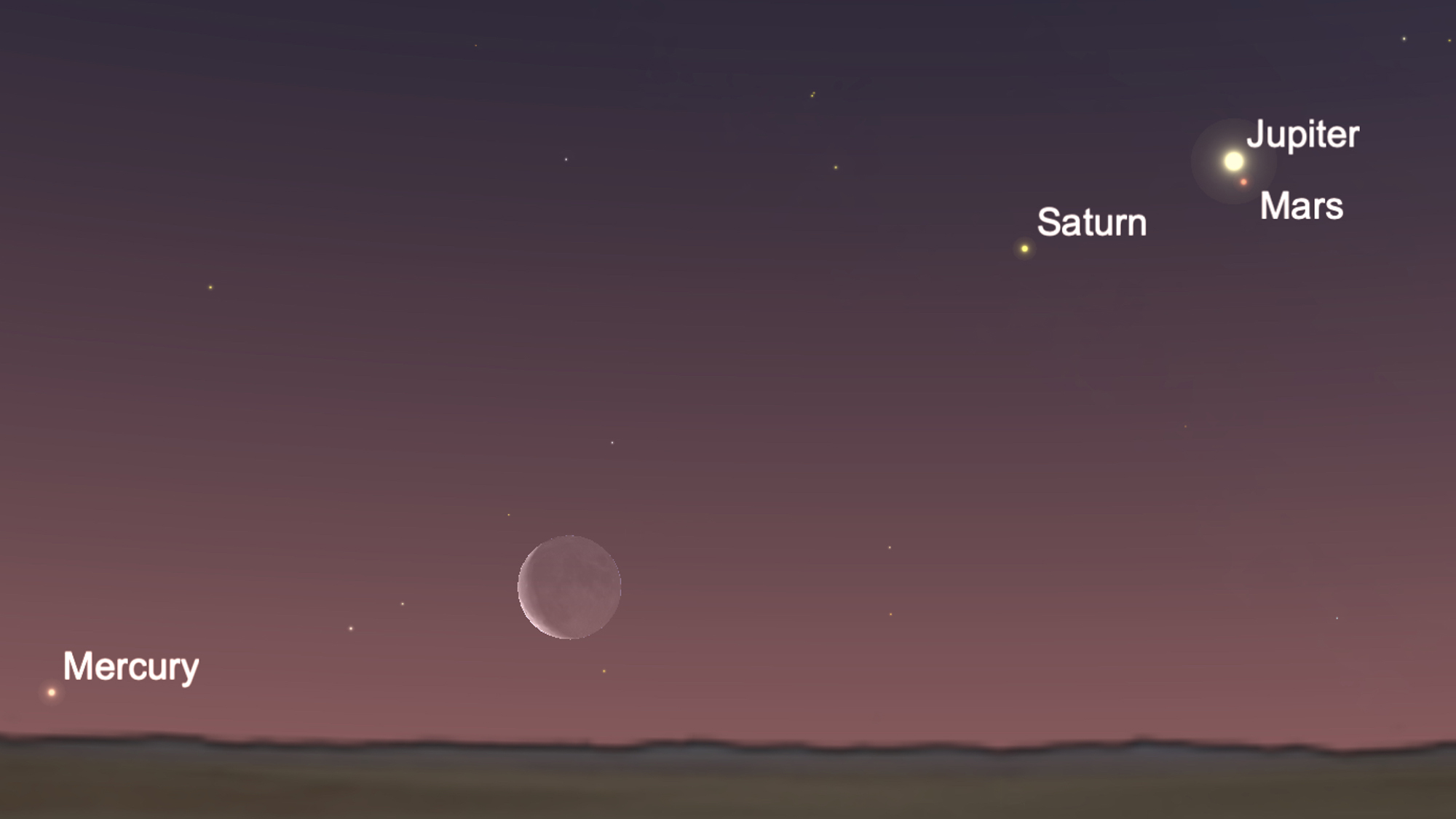You can see Jupiter and Mars snuggle up in the predawn sky Friday. Here's how.
Early Friday morning (March 20), Jupiter and Mars will make a close approach, and you can catch them together with Saturn and the crescent moon.
Jupiter and Mars will be in conjunction, meaning they share the same celestial longitude, at 2:21 a.m. EDT (0621 GMT), according to In-the-Sky.org. The two planets will make their closest approach, also known as an "appulse," 4 hours later, at 6:33 a.m. EDT (1033 GMT). At that time, they will be less than 1 degree apart. (For reference, your fist held at arm's length measures about 10 degrees wide.)
For skywatchers in the eastern United States, the moment of the planets' closest approach happens about 30 minutes before sunrise. In New York City, for example, both Jupiter and Mars will rise around 4 a.m. local time, so viewers will have at least a couple hours to see them before they fade into the daylight. In parts of the world where Jupiter and Mars are below the horizon during the encounter, the two planets will still appear close to each other once they peep over the horizon in the morning. Look for the pair above the southeastern before dawn.
Related: Best night sky events of March 2020 (stargazing maps)
Jupiter and Mars won't be the only two planets visible in Friday's morning sky. Saturn will also be shining brightly to their left. And if you have a clear horizon, you may be able to spot the tiny planet Mercury just before sunrise. Mercury will rise in New York City at 5:58 a.m. local time, exactly 1 hour before sunrise. To find out exactly when and where the planets are visible from your location, check out this handy night sky calculator by Time and Date.
While Jupiter and Mars will be snuggled up close in the constellation of Sagittarius, the archer, Saturn will be straddling the border between Sagittarius and its neighboring constellation of Capricornus, the sea goat. The waning crescent moon will rise in Capricornus about half an hour before Mercury, and about 90 minutes after Jupiter and Mars.
Because Mercury is so close to the sun in Earth's sky, it is notoriously difficult to spot. But the innermost planet is just a few days away from its greatest western elongation, or its greatest separation from the sun, making this a great time to try to see it. On Monday (March 24), when Mercury reaches its greatest elongation, it will reach an altitude of about 11 degrees by the time the sun rises, giving skywatchers a longer opportunity to see it (safely) without any obstruction from sunlight.
Breaking space news, the latest updates on rocket launches, skywatching events and more!
- The brightest planets in March's night sky: How to see them (and when)
- Space calendar 2020: Rocket launches, sky events, missions & more!
- See the Spring Diamond shine in the night sky
Email Hanneke Weitering at hweitering@space.com or follow her @hannekescience. Follow us on Twitter @Spacedotcom and on Facebook.
OFFER: Save at least 56% with our latest magazine deal!
All About Space magazine takes you on an awe-inspiring journey through our solar system and beyond, from the amazing technology and spacecraft that enables humanity to venture into orbit, to the complexities of space science.

Hanneke Weitering is a multimedia journalist in the Pacific Northwest reporting on the future of aviation at FutureFlight.aero and Aviation International News and was previously the Editor for Spaceflight and Astronomy news here at Space.com. As an editor with over 10 years of experience in science journalism she has previously written for Scholastic Classroom Magazines, MedPage Today and The Joint Institute for Computational Sciences at Oak Ridge National Laboratory. After studying physics at the University of Tennessee in her hometown of Knoxville, she earned her graduate degree in Science, Health and Environmental Reporting (SHERP) from New York University. Hanneke joined the Space.com team in 2016 as a staff writer and producer, covering topics including spaceflight and astronomy. She currently lives in Seattle, home of the Space Needle, with her cat and two snakes. In her spare time, Hanneke enjoys exploring the Rocky Mountains, basking in nature and looking for dark skies to gaze at the cosmos.



